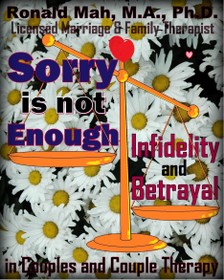Conclusion - RonaldMah
Ronald Mah, M.A., Ph.D.

Licensed Marriage & Family Therapist,
Consultant/Trainer/Author
Main menu:
Conclusion
Therapist Resources > Therapy Books > SorryNotEnough- Infidelity-Cpl

Sorry is not Enough, Infidelity and Betrayal in Couples and Couple Therapy
CONCLUSION
by Ronald Mah

What of the couples described in this book? Did they reconcile? Who did and who did not? Who could and who could not reconcile, recover, and heal? The therapist’s premise is that all couples can reconcile, recover, and heal. However, not all couples will. Their underlying issues that created their respective contexts for infidelity need to be identified. The logical theoretical conceptualization and the subsequent therapeutic strategies for reconciliation, recovery, and healing are hypothesized. When the therapist can facilitate or the couple can actualize the strategies, the likelihood of the partners staying together increases. The therapist’s responsibility is to give the partners their best chance to stay together, and then leave it to them to decide if they will. With the couples referenced, it is left to the reader’s imagination with each couple whether the relationships continued, in what form, and/or if infidelity was repeated. The exception to leaving it to the reader’s imagination is the couple of Aidan and Cathy.
Aidan and Cathy developed exceptional dedication to the couple therapy process. As with many couples, they entered therapy in crisis with an immediate goal to find out if the process with therapy was viable. Since the therapist and the therapy offered enough hope based on their early experiences, the partners decided to use the process see if they could stay together. It took four to six sessions for them to gain enough tentative confidence in the therapist and therapy to commit to the couple therapy… tentatively. Realistically, it was a few months, before they trusted the therapist to manage their process. Although uncertain about therapy, Aidan wanted to stay together with Cathy no matter what. He was adamant. Cathy did not know if she wanted to stay together with Aidan, but knew that they had to get help through therapy. She did not know if she hated Aidan too much or if she could tolerate the process to figure it out. Almost every issue discussed in this book occurred with Aidan and Cathy. The process was often identifiably cyclical with therapy returning to the same issues repeatedly. Over time, they realized that although they ended up dealing with the same issues over and over, they gradually did so with greater depth and nuance. Nothing ever got resolved and did not require re-visiting. There was small inconsistent uneven incremental growth and changes. Over the longer process, small gains would periodically accumulate sufficiently to hit a critical mass of emotions, insight, and behaviors that allowed qualitative growth and change.
Interestingly, the therapist noted qualitative changes before the partners noticed, starting with Aidan and Cathy’s confidence in the therapist and therapy. They tried to follow through on strategies and interventions discussed, and made inquiries that showed their respect for the therapist’s expertise, insight, integrity, and experience. With the therapist’s prompting, Aidan and Cathy worked simultaneously on working through the multiple levels of the affair context and on being healthier as individuals and partners. The quality of their relationship improved and grew markedly despite continued anger and confusion about the affair. They noted and validated each other’s attempts at listening, being respectful, considerate, and nurturing. Despite frequent and intense eruptions over affair details- especially about Tina, Cathy could honestly say that Aidan was a better person and a better partner than he had been before. Whenever there were work and extended family challenges for either partner, they unified and worked together with respect and mutual support. They identified that if they had functioned in this way prior to the affair, that the context for infidelity would never have developed. Aidan was more self-aware and strived to be more emotionally open- not to compartmentalize himself as before. He was able to deal with stress much more proactively. Rather than doing what needed to be done without calculation, both Aidan and Cathy held selves and prompted each other to consider the costs to emotional, spiritual, and physical energy first. They respectively targeted for change any personal habits including understanding their origins, that were not productive.
Aidan and Cathy participated in three plus years of couple therapy… difficult, grueling, volatile, infuriating, depressing, and overwhelming therapy. It took more than 300 sessions: weekly or bi-weekly individual sessions and mostly weekly two-hour couple therapy sessions. It was an extensive time, financial, and psychic investment. It was critical to remember that it was a commitment and investment to salvage, save, and heal an almost three decade relationship. It took a good part of the years of therapy and repeated review to understand themselves and the development of the context of the affair. Still sad and angry about the infidelity, both Aidan and Cathy could now make sense of it all. Close to four years after the uncovering of the affair, Cathy knew she would still have flashbacks, but less frequently and less intensely. She also had found ways to self-soothe and center herself when they happened, and was significantly less likely to lash out at Aidan. Four years after ending the affair, Aidan remained dedicated to Cathy and the marriage. He understood how he became vulnerable to infidelity over the course of the years. As Aidan put it, when he had gotten to the 99th level of fatigue, stress, resentment, entitlement, and need, he had become vulnerable and ripe for picking. That was when Tina picked him. Now, he watches himself as he goes through the 1st level to 40th level, and activates self-care behaviors so he does not go further. Both Aidan and Cathy are more of the persons each respectively wish to be. They each are more again of the person the other loved and respected, and now love and respect each other more than ever. Aidan has recruited and empowered Cathy to be an observer and interventionist to check in with him regularly about his stress level. Aidan does this for Cathy as well. Both partners needed to challenge and adjust their habitual instincts to just “step up,” “just do it,” and to do it alone. Duly humbled by the affair, Aidan and Cathy are active in recovery and healing, continually growing and trying to become healthier.
Aidan and Cathy represent a success story of couple therapy and recovery and healing from infidelity. Of the most important significance was that it took a long time and was an arduous emotionally agonizing process for them. While not all couples require three plus years of therapy to recover and heal from infidelity, the process takes significant time and energy. A quick fix is almost certainly a poor fix. Infidelity is much too complex a violation of mutually agreed and strongly held values and behaviors for a simple or prescriptive recovery and healing process. Many interventions and strategies effective for Aidan and Cathy would also be appropriate for other couples, but also may not be successful. Peter and Winona comprise a different couple with Peter and Winona being different individuals. The other couples also discussed here hardly can represent all the variations of partners and infidelity: Bart and Helen, Chase and Angie, Francine and her current partner, Rosalyn and Jeff, Mabel and Simone, Leia and Herbert, and Stephan and Ray, or Randle, Chuck, and Joaquin each with two wives.
Along with addiction issues, infidelity in couple therapy may be the most difficult clinical challenge for the therapist. Infidelity triggers just about any and every issue for each and both partners. The couples therapist must be prepared to identify these issues and deal with each and perhaps, all of them as needed. Chances are in couple therapy, the therapist will find many complicated and often provocative issues to deal with in helping a couple recover and heal from infidelity. Or, to help one or both partners to decide if the relationship or the other partner is worth the work to keep. And/or to help one or both partners discover if they have the will and strength to try to recover, heal, and reconcile. The therapist can be a great assistance to help the partners engage in these processes and make these determinations. However, the therapist must remember it is not his or her responsibility to save the relationship. That is not the therapist’s decision whether the previously committed partners should live together, stay committed, continue in some altered form, or end the relationship. In helping the partners experience a clear nuanced process of complexity and depth, the therapist enables them to make the most informed and healthy decision going forward. For the partners and the therapist, if the relationship recovers and heals enough to allow it to go forward in a healthier more mutually beneficial manner, everyone can be satisfied and fulfilled. If the relationship ends on the other hand, both partners and the therapist may be able to move on with regret and remorse, but hopefully without shame and guilt. Everyone hopefully can have regret yet accept him or herself and each other, and that the relationship does not work anymore. The other relationship- couple therapy with the therapist did not work for the partners to stay together, which may be regretted and also accepted. If the partners cannot move on without negative emotional and psychological consequences, then the therapist needs to be able to move forward without professional guilt. A partner or a couple may blame a therapist for not “saving” or “fixing” an adulterer or the relationship. In gaining conceptual wisdom and relevant knowledge, the therapist can regret that his or her work was not sufficient to achieve the partners’ goals, but accept having done the best he or she theoretically and clinically can do. Then will therefore not be any need to forgive him or herself. Partners may not accept the context of their affair, but the therapist must accept the context of the therapy. The therapist who works with the partners to learn who they are will also understand why therapy may be or not be successful.

